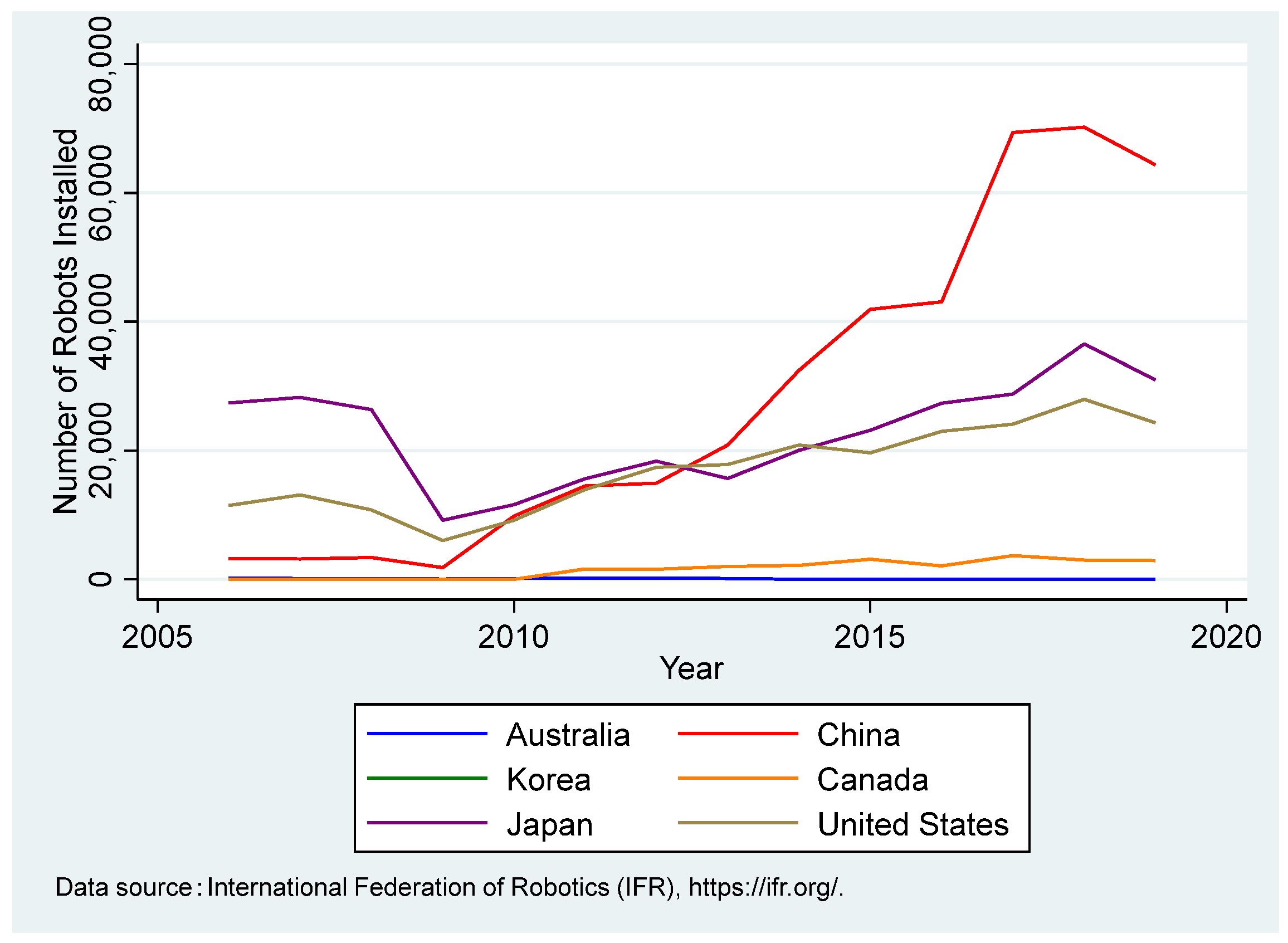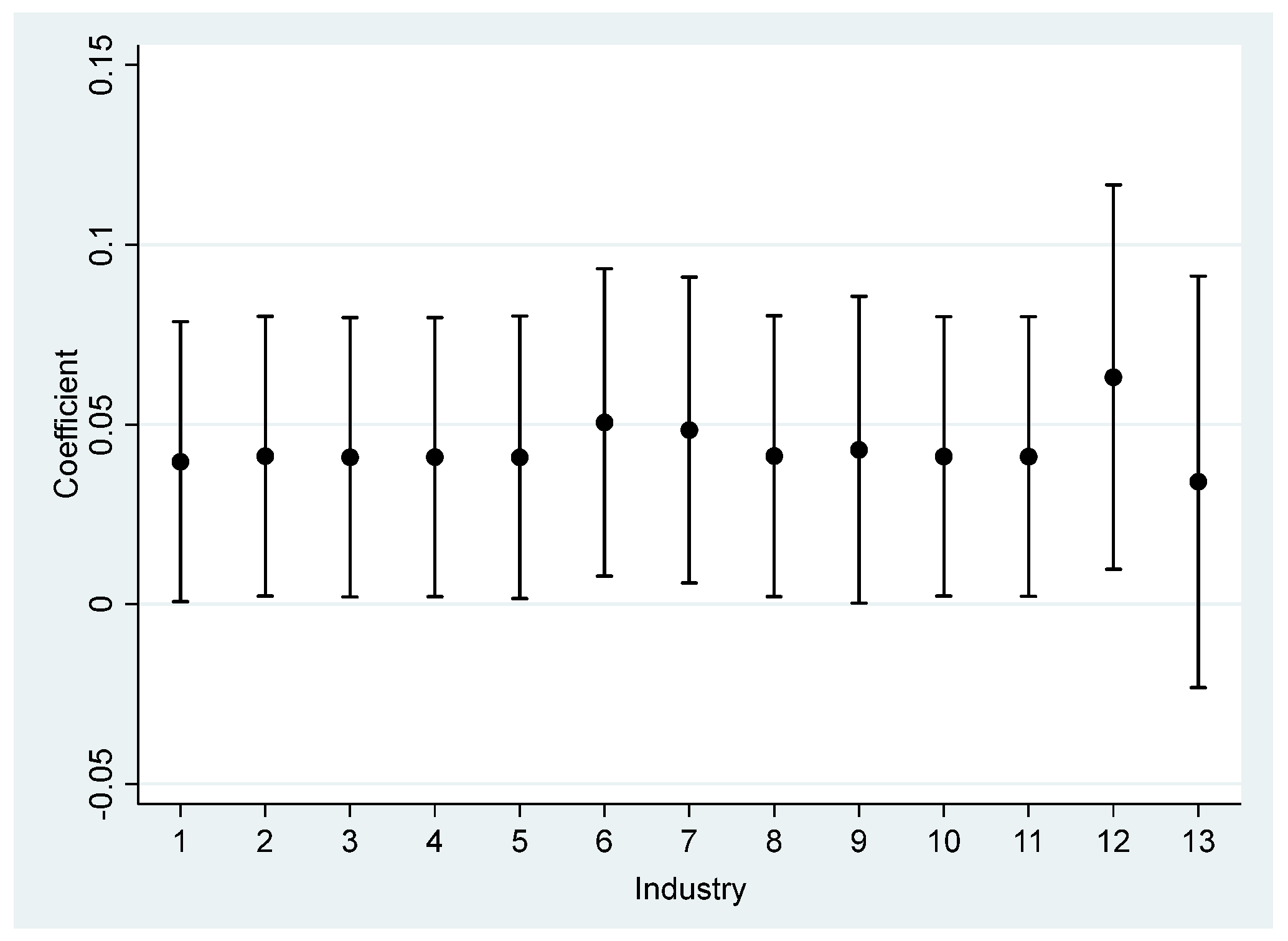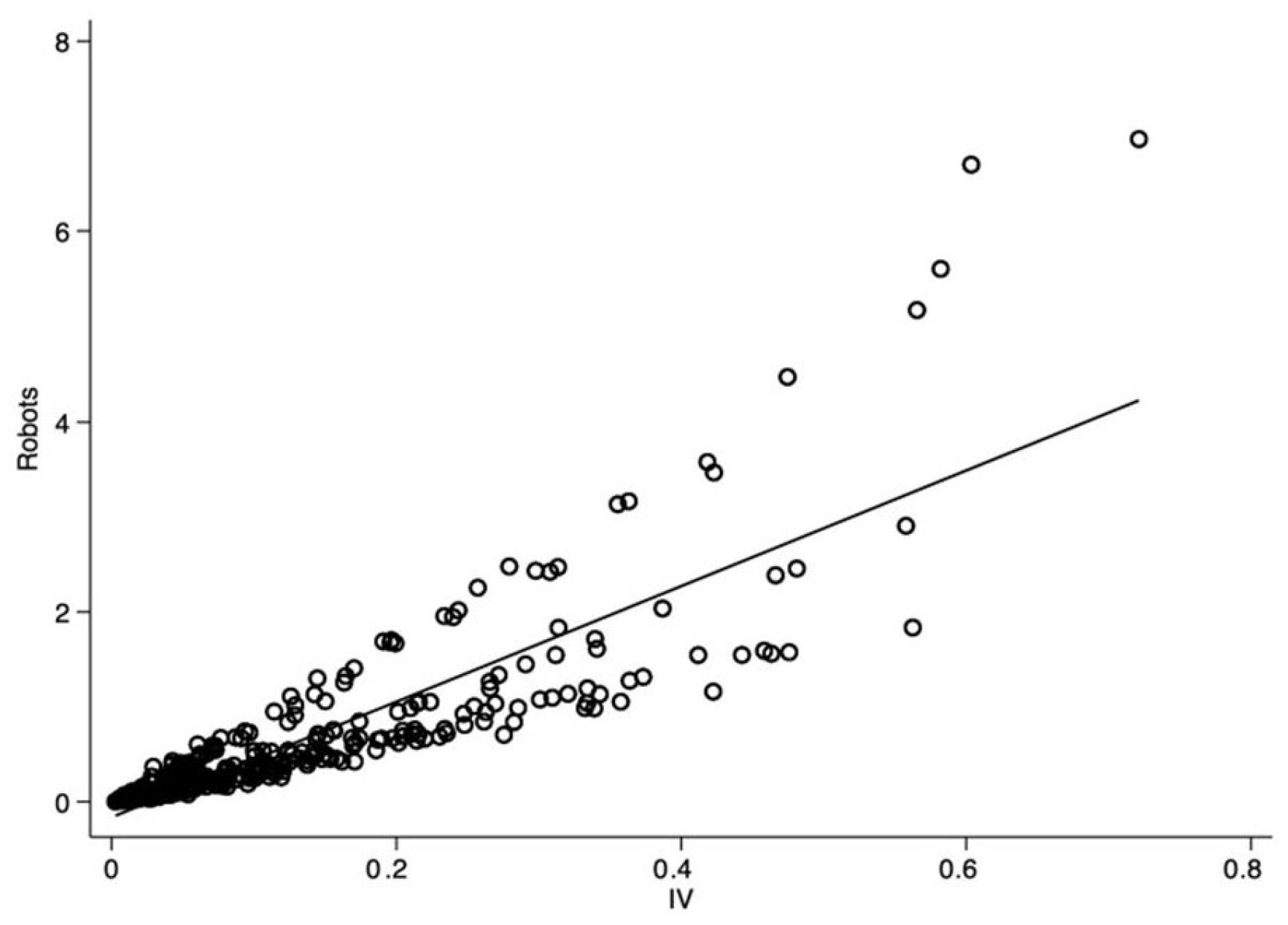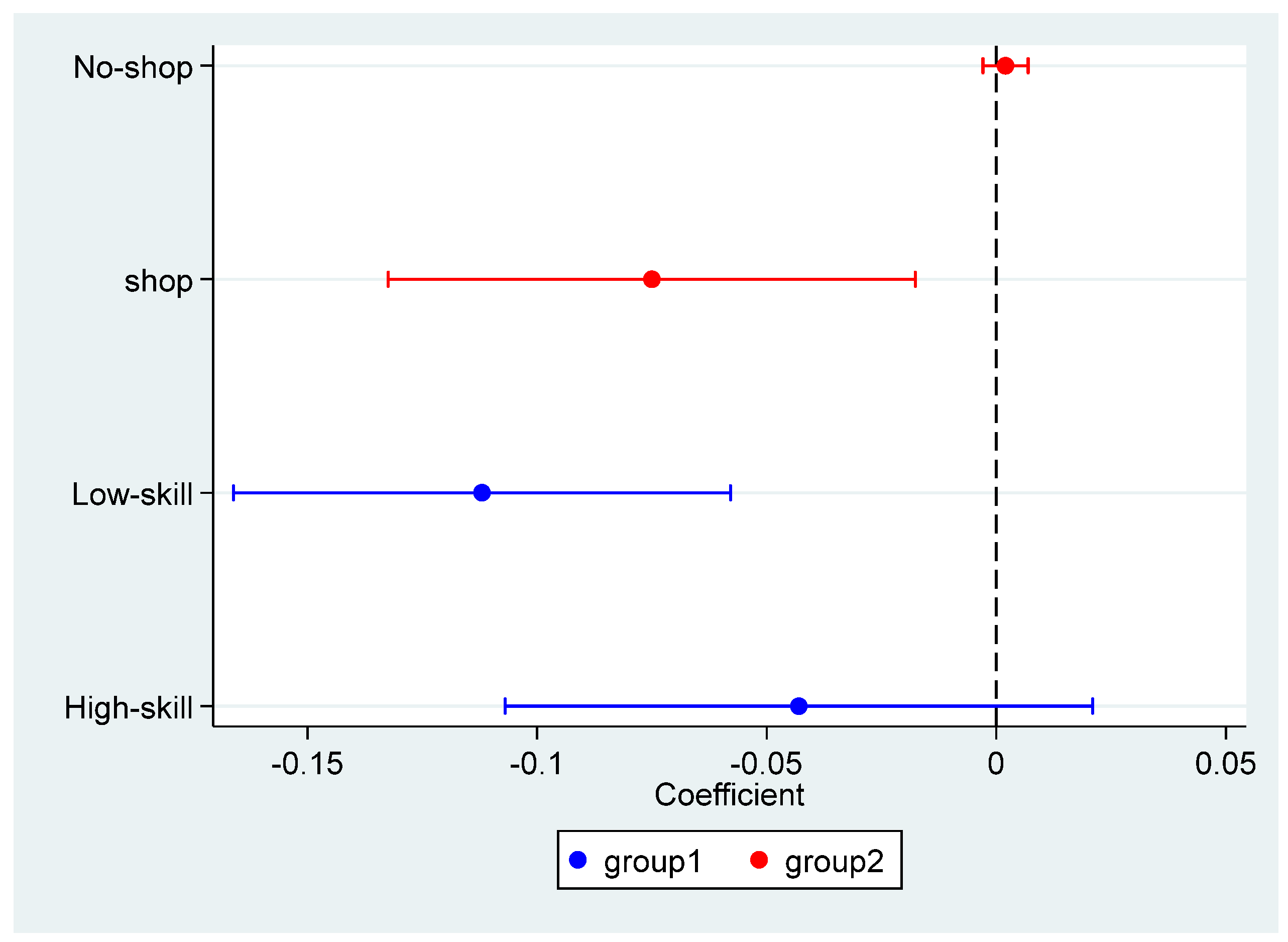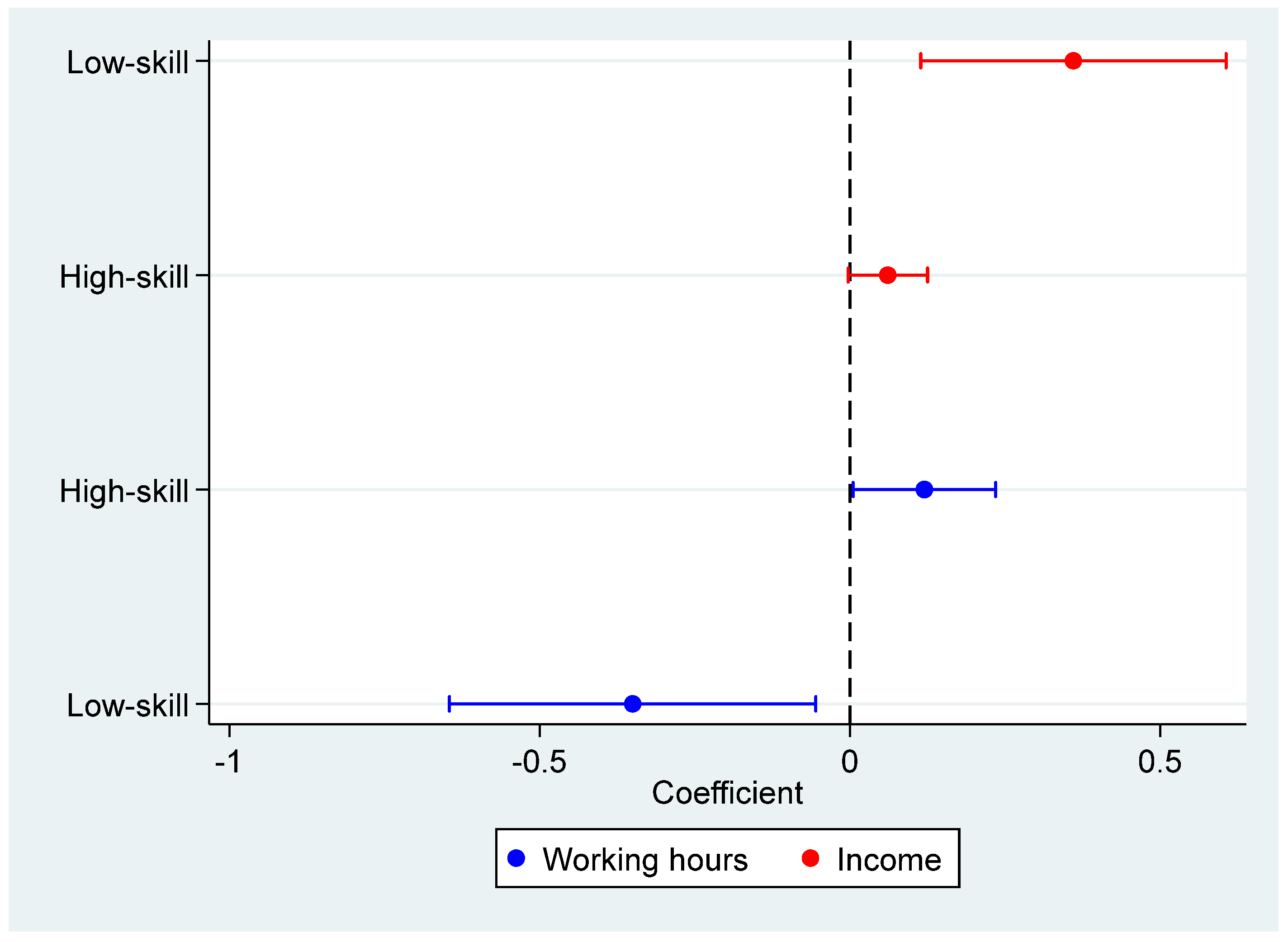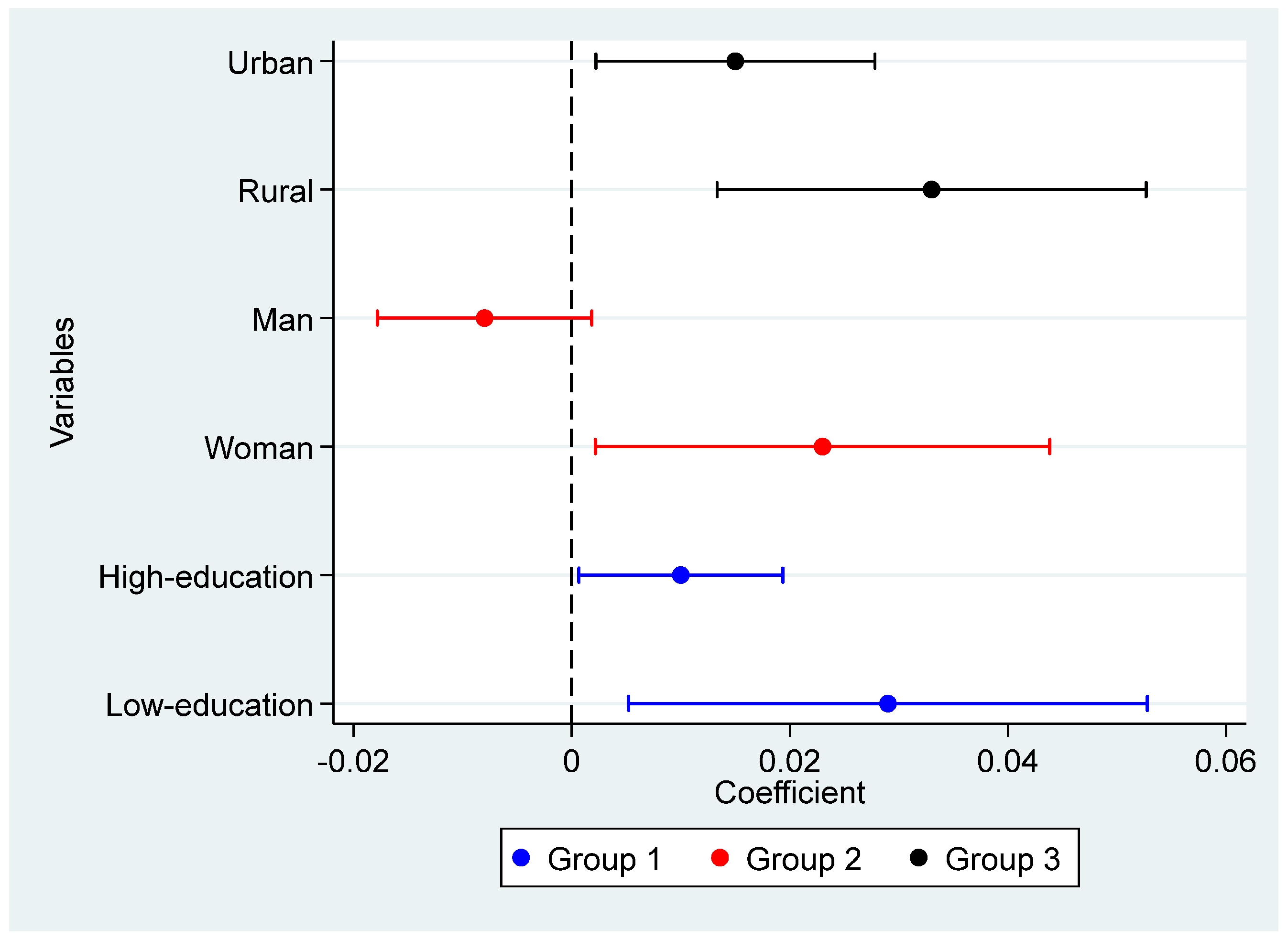1. Introduction
Due to the size of China’s population, previous studies have tended to focus on the “economic dividend of labor” [
1,
2,
3]. With the aging population of Chinese society [
4], studies have begun to focus on workers’ health [
5,
6]. In developing economies, the sustainability of the health of the workforce is important for productivity gains, thus contributing to overall economic growth [
7,
8]. Labor health issues have been widely discussed, especially after the global COVID-19 pandemic [
9]. The classical economic school argues that the rational division of labor can effectively improve the efficiency of economic growth, and the neoclassical economic school focuses on the role of mutual knowledge spillovers and innovation in human capital. In addition to the differences in productivity and innovation ability, human capital should also include the health level of laborers. Based on the current stage of China’s economic development, maintaining economic growth while taking into account people’s livelihoods is the proper meaning of realizing high-quality economic development. However, the phenomena of “occupational disease”, “overwork”, and “overtime culture” are emerging in today’s society and seriously threatening workers’ health [
10,
11]. As the core concept of healthy and sustainable development is people-centered, these phenomena need to be urgently ameliorated.
The level of worker health as an expression of individual well-being is closely linked to economic growth [
12]. The first strand of the literature relevant to our study is research related to health economics [
13,
14]. More economically developed areas often have better living conditions, nutritional intake, and public health, which in turn improves the health of the population [
15,
16]. At the macro-level, high economic growth allows governments more room to restructure public health expenditure and health care financing funds to act as a promoter of workers’ individual health [
17]; at the micro-level, Tanaka (2020) argues that when rapid economic growth in developing economies gives domestic firms greater access to international markets, it can positively affect workers’ living environments by improving working conditions, such as fire safety and health care [
18]. However, economic growth does not always have a positive impact on workers’ health, and the process of industrialization, with its high energy consumption and pollution, can damage ecosystems and impose heavy social health costs on the population [
19]. Especially for developing economies, as “catching-up” societies, relying on the large markets of developed economies to carry out trade activities is an important channel to achieve economic growth, and relevant studies have also shown the existence of “sweatshops” in developing economies [
20]. China’s early foreign direct investment has also turned China into the world’s sweatshop [
21,
22].
A second strand of the literature related to the text focuses on the economic growth effects of industrial robots [
23,
24]. Undoubtedly, China’s economic growth in recent years has entered a new channel, and the traditional model of crude economic growth that relies on processing trade no longer meets the requirements for high-quality development of the current economy. The previous literature represented by trade development can no longer explain the new changes that have occurred with respect to worker health. With the rapid advancement of artificial intelligence technology, countries are using industrial robots in the automotive, electronics, logistics, and transportation fields to find a new engine of economic growth [
25,
26,
27]. Germany has embarked on “Industry 4.0”, the U.S. is moving toward an “Industrial Internet”, and the Chinese government has increased its investment in industrial robots in recent years [
28,
29]. According to the International Federation of Robotics (IFR), China’s installed base of industrial robots was predicted to grow at a rate of 44% in 2021, accounting for half of the global robot market share. It is worthwhile to pay attention to whether the large-scale use of industrial robots can change the economic phenomenon of “sweatshops”. Industrial robots, as a technology-intensive and capital-intensive product, have similar aspects to traditional intermediate goods and can be viewed as an aspect of technological advancement in production, by changing the production model in order to enhance the efficiency of economic growth [
30]. However, unlike general intermediate goods, the use of industrial robots also has a skill complementarity effect that creates new tasks and new demand [
31]. In addition to this, industrial robots also have substitution effects, with one study finding that the extensive adoption of industrial robots on the production side in the United States reduces production costs, thus reducing the need for imports from Mexico to protect its manufacturing sector [
32]. Subsequent empirical studies have used the above framework to explore enterprise productivity [
33], labor income [
34], and interregional labor migration [
35]. Our study provides more micro-empirical evidence on how industrial robot use can better utilize human capital for sustainable economic growth.
Although the existing literature is less concerned with the effects of the use of industrial robots on the health of laborers, the related literature focusing on how industrial robots affect the individual utility of laborers has inspired our research more than anything else. In particular, Acemoglu and Restrepo (2020) theoretically analyzed the micro-impacts of industrial robots on workers by nesting a model of the firm’s production tasks into the firm’s supply function [
36]. Similarly to previous research, the theoretical analytical framework of our study still follows the same micro-mechanisms, but with the difference that it systematically analyzes the possible double crowding-out and crowding-in effects of different heterogeneous groups, based on the perspective of individual worker health. In addition, this research is also related to the literature focusing on the use of industrial robots and inequality, such as the skill income gap [
37], the gender income gap [
38], and the income gap between capital and labor owners [
39]. Our study adds to the literature on labor economics by focusing further on health inequalities among workers.
The research focus of our study is as follows. Firstly, we emphasize the theoretical association between industrial robot use and workers’ health through mathematical modeling. Secondly, a key part of our research involves constructing an empirical model to verify our theoretical hypotheses using relevant data. Thirdly, we empirically test our theoretical mechanisms from macro-, meso-, and micro-perspectives. Fourthly, whether there is heterogeneity in the effects of industrial robots on workers’ health is also a central focus of this paper. Finally, we use the moderating effect to further analyze how to protect workers’ rights and interests in the context of “machine replacement.”
Firstly, existing research has confirmed that the use of industrial robots has had a profound impact on the labor market, including on wages and employment [
40,
41]. New technologies represented by industrial robots have increased labor productivity, optimized production processes, and enhanced workplace safety [
42]. In particular, industrial robots have a substitution effect that frees workers from heavy physical labor. Our results find that industrial robots directly enhance workers’ health, which coincides with existing research findings, with the difference that our perspective is more direct and micro. Secondly, while our study finds that industrial robot use generally enhances the health effects of laborers, it may adversely affect urban, high-skilled, and male groups due to the simultaneous creation effects of industrial robots. This is in contrast to existing studies that focus only on the overall effect [
43]. Finally, we find that narrowing the income gap between workers and strengthening the protection of workers’ rights and interests can effectively avoid the adverse effects of robot use, which suggests that our study has certain policy implications and can make targeted adjustments to the existing labor rights and interests protection policies.
2. Theoretical Framework
Health economics and labor economics suggest that hourly effects, income effects, and environmental effects are the main channels affecting workers’ health, and existing research also suggests that workers’ hours of work and wage income determine the economic effects of industrial robot use [
44]. The basic idea of the theoretical model construction in our study is to nest a robot production model with a sequence of jobs into a general equilibrium production function. The decision-making behavior of firms is affected by the cost of robot use (the cost required to purchase industrial robots) and the cost of labor (wages); at the same time, it is assumed that the cost of labor is heterogeneous across skill groups. Ultimately, the impact of robots on the labor force will be affected by individual skill heterogeneity of the labor force and affect the health of the workers. The theoretical framework is shown in
Figure 1. The leftmost figure indicates that the use of industrial robots acts first and foremost in two different sectors, namely the production sector and the innovation sector. The intermediate flow parallel process diagram indicates that the production sector primarily affects low-skilled labor groups, including the female population, rural households, and low-educated workers, while the innovation sector primarily affects high-skilled groups, including males, urban households, and highly educated groups. Finally, it is passed on to health by affecting labor intensity and income.
2.1. Demand
The CES function is widely used in individual utility analysis and can accurately explain the composition of an individual’s welfare [
45,
46]. Therefore, we further incorporate the intensity of the laborer’s work on top of the CES and set the following utility function:
q represents the quantity consumed, represents the elasticity of substitution between goods, h represents the number of hours worked by the laborer, 0 < θ < 1 represents the sequence of jobs that the robot can perform, which reflects the elasticity of substitution between the laborer and the robot, represents the elasticity of substitution between labor and robots, and Equation (1) introduces the laborer’s hours of work into the traditional CES utility function, showing that the laborer’s utility is determined by both the consumption of the final goods and the hours of work determined by the robot’s efficiency.
Assuming a wage of
w, which is similarly affected by the sequence of jobs performed by the robot, the individual income budget constraint is satisfied:
According to the first-order condition of profit maximization of the enterprise, the product demand function and the composite price index can be obtained to satisfy the budget constraints.
E represents the total spending of all residents and can be treated as a constant.
Combining Equations (1) with (2) creates a Lagrangian function and derives it for the individual’s working time
h:
According to Equation (5), the consumer’s indirect utility function is given as follows:
The economic implication is that higher incomes and lower prices lead to higher levels of consumer welfare.
is a constant term, and according to the relevant definition of health economics, the health level of workers is part of individual welfare, which is assumed to satisfy the following equation:
denotes the risk of illness or injury to the worker, which is a positive function of the number of hours worked by the worker, and M represents the cost of medicine borne by the worker.
Corollary 1: From Equations (5) and (7), it can be concluded that the income of individual laborers changes in the same direction as the number of hours worked, and that an increase in the use of industrial robots by firms will have an impact on laborers’ incomes and the number of hours worked in the same direction.
2.2. Supply
The production chain is usually set up using a CD function, which is usually able to include relevant inputs such as the quantity of labor and intermediate goods [
47,
48]. Since industrial robots play a role mainly on the production side and are also a type of input factor, our study introduces robots on top of this by setting the following equation:
Rm stands for the number of industrial robots, L represents the number of laborers, which is also affected by the productivity of the robots, β denotes the elasticity of substitution between laborers, and represent the productivity of the industrial robots and laborers, respectively, K represents capital, and α represents the production shares of laborers and robots.
Based on the nature of the CD function, the marginal cost of the vendor’s supply is as follows:
denote the marginal cost of production of robots, labor, and capital, respectively. When production efficiency is , robots completely replace labor, and the marginal cost of vendor supply is . When production efficiency is , robots are not as productive as human capital, and the marginal cost of vendor supply is . There is a wage gap between skill groups . We further assume that the cost of using robots in a firm is ; this is because the more labor there is, the more robotic equipment you need to invest in.
2.3. Equilibrium
The profit of an enterprise is derived from operating income minus the cost of labor, the cost of purchasing robots, and the cost of fixed investments. We set the profit function of the firm as follows:
At an equilibrium wage level in the labor market, the firm will choose the optimal number of workers and hours of work to maximize profitability, so the first-order condition of Equation (10) is satisfied.
Combined with Equations (11) and (12), we obtain the following:
From Equation (5), we can further conclude
Combining corollary 1 and Equations (8) and (14), we can observe that the direction of change of and is the same, indicating that only when the profit increases will the enterprise expand the scale of production and increase the input of labor; similarly, when the enterprise’s profit decreases, the enterprise will reduce the scale of production and reduce the input of labor. Therefore, the output maximization behavior of enterprises under the use of industrial robots determines the impact of the use of industrial robots on the working hours and income of workers, which in turn has an effect on the health of workers.
Using Equation (3) to obtain a partial derivative for
θ yields the following equation:
Assuming that the marginal cost of the skill threshold is , there is always a part of the high-skill group that is more productive than the robot, meaning ; similarly, there is a part of the low-skill group that is less productive than the robot, meaning .
When workers are in the high-skilled group, then
and
. Because the high-skilled group is more likely to be engaged in creative and unconventional work, the increase in output resulting from the use of industrial robots needs to be complemented by the high-skilled group, e.g., in the computer, information, and communication sector [
49]. When industrial robots enter sectors where high-skilled groups are located, on the one hand, the skill complementarity effect allows firms to create more jobs and task segments, which can increase the number of hours worked by employees, negatively affecting the level of health; on the other hand, for highly skilled workers, an increase in the number of hours worked leads to an increase in job earnings. When the labor force is a low-skilled group,
and
. This is because the low-skilled group is more likely to engage in simple labor outsourcing jobs, and the processes performed are in a substitution relationship with industrial robots, such as the blue-collar sector concentrated on the shop floor [
44]. When industrial robots enter the sectors where low-skilled groups are located, the substitution relationship between the two leads to additional production costs faced by firms. When rational firms reduce the input of low-skilled labor, the reduction in working hours positively affects the health level of low-skilled groups, and the level of workers’ income decreases as well.
Proposition 1: Industrial robots affect laborer health by affecting work intensity and income levels.
8. Discussion
In summary, the marginal contribution of our study is based on the following four aspects. Firstly, previous research has predominantly focused on the economic efficiency generated by robots and industrial upgrading. Each standard deviation increase in the number of industrial robots in use results in a 0.032 standard deviation increase in the number of patent applications [
55,
56]. Our study takes a more microscopic view of how industrial robots affect the personal health utility of workers, and the results show that the use of robots significantly improves workers’ health. For every unit increase in the penetration of industrial robots in a city, the probability of worker health in that area increases by 4%. Secondly, we inherit the theoretical analytical framework of existing industrial robotics research [
55,
56,
57,
58]; for example, industrial robots increase total employment but have an employment shock of −0.004 for low-skilled groups [
57]. Our study is similar to it in terms of mechanism and finds similar crowding-out and crowding-in effects of industrial robots on health. Thirdly, high work intensity can result in negative health shocks of −0.164 and −0.201 for American and Chinese workers, respectively [
58,
59], and the ability of robots to improve the work environment has been widely demonstrated [
60,
61,
62]. Our study further reveals that robots can reduce work intensity, thereby enhancing workers’ health. Finally, while much of the existing literature has focused on the inequality effects of industrial robots, such as employment inequality, income inequality, and resource inequality, especially the polarization that has occurred in Europe and the United States [
63,
64,
65], our findings suggest that industrial robots have more favorable health effects on low-skilled, female, and rural workers, helping to narrow the health gap among different groups of workers.
In addition to expanding the literature on industrial robots and workers’ personal utility, our research forms a theoretical expansion of labor economics, health economics, and industrial economics. It also provides policy recommendations for the sustainable development of China’s economy at a more micro-level, as follows. Firstly, the government should recognize the favorable aspects of “machines replacing humans”, maintain a positive outlook on the social issues caused by the use of industrial robots, and encourage enterprises to pursue “intelligent” transformations and industrial upgrades. This will enhance workers’ health through technological advances, promoting social stability and harmony. Secondly, while enterprises are upgrading intelligently and completing technological progress, the government should pay attention to the protection of workers’ rights and interests, expand labor dispute resolution channels, and urge enterprises to improve the vacation system and advocate flexible working hours to reduce the working hours of workers whose working hours have increased. Thirdly, the use of industrial robots may further exacerbate income inequality and reduce the effectiveness of workers’ health. Therefore, the government should further improve the income distribution system, narrow the income gap between occupations and industries, and realize the positive effects of industrial robots on workers’ health by strengthening the protection of low-income groups and providing vocational training.
9. Conclusions
Our study integrates the task model represented by industrial robots into the relevant theories of labor economics and health economics, extends the equilibrium analysis of workers’ individual utility by taking working hours and working income as the entry point, and matches the 2010–2015 CGSS database with the IFR database to verify the impacts and mechanisms of the use of industrial robots on workers’ health. The results show that, firstly, with each unit increase in the penetration of urban industrial robots, the probability of improved labor force health in the region rises by 4%. Secondly, mechanistic analysis reveals that the application of industrial robots significantly reduces the number of safety accidents at the macro-level and decreases laborers’ working hours at the micro-level, both of which positively impact labor force health. Thirdly, heterogeneity analysis indicates that, due to the substitution effect of industrial robots, low-skilled workers, female workers, and rural-household-registered workers benefit more in terms of health. Lastly, strengthening protections for workers’ rights at the macro-level and narrowing the income gap within regions can effectively mitigate health polarization among different skill groups, thereby maximizing the potential of industrial robots to enhance productivity while safeguarding workers’ rights.
The rapid growth of industrial robot applications in China provides a wealth of data to study their effects on health. Globally, this phenomenon is a reminder that countries cannot ignore the health of highly skilled workers when promoting industrial automation and intelligence. China’s rapid growth in industrial robotics adoption is part of a global wave of automation. Many countries, such as Germany, the United States, Japan, and South Korea, are also actively promoting industrial automation and intelligence. This global trend means that all countries are facing similar challenges of how to improve productivity while ensuring the physical and mental health of workers. China’s experience can provide lessons for other countries to help them better balance technological advancement with humanistic care. Technological progress should not come at the expense of workers’ well-being. Global policymakers can strengthen cooperation through international organizations (e.g., the International Labor Organization, the World Health Organization, etc.) to promote more humane workplace standards. For example, a global code of ethics for automation could be developed to ensure that technological advances evolve in tandem with worker well-being.

